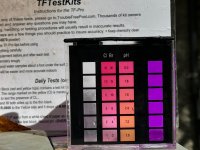- Aug 19, 2022
- 77
- Pool Size
- 34000
- Surface
- Plaster
- Chlorine
- Salt Water Generator
- SWG Type
- CircuPool RJ-60 Plus
Hi TFP friends! I need some help.
For background, I'm in the process of closing for the first time by myself . My chemistry had been balanced and very predictable for months (thanks to TFP). After doing a "soft close" on Saturday (solid cover on, but pump still running), I'd passed my OCLT, had FC perfect at 1/2 SLAM level, and was just waiting a few more days to get my temps solidly below 60F before winterizing. But then I added Polyquat... and my pH results went crazy! Here are more details of what happened:
. My chemistry had been balanced and very predictable for months (thanks to TFP). After doing a "soft close" on Saturday (solid cover on, but pump still running), I'd passed my OCLT, had FC perfect at 1/2 SLAM level, and was just waiting a few more days to get my temps solidly below 60F before winterizing. But then I added Polyquat... and my pH results went crazy! Here are more details of what happened:
At this point, I started searching through TFP forums. I found this discussion which suggested that the result might be an artifact -- a false reading from the drop test. In fact, I'd seen that same "iridescent magenta" color in my comparator once before: last year after my PB closed my pool (they also used Polyquat, although I previously thought that they really did shoot up my pH by using a weird borate-containing winter float ).
).
Since I wanted an independent check of the pH reading with any other methodology than my Taylor test, I just went to Leslie's for the first time in about a year (I know, I know -- I'm sorry! ). Their results: pH=8.1 (ok, maybe...), and TA=5 (false for sure! My TA has been rock-solid stable at 70).
). Their results: pH=8.1 (ok, maybe...), and TA=5 (false for sure! My TA has been rock-solid stable at 70).
After coming home, I've rerun my Taylor test several times (I'm using R-0004/T-9056). The end result is always that same "iridescent magenta" color, suggesting that my pH is 8.0++ (picture below). But after several runs, I've noticed something interesting: the sample first flashes orange (pH=7.4-7.6 range) for the briefest of moments... before quickly turning magenta -- only for about a second as I'm shaking the comparator.
Based on the prior TFP discussion I've linked above, my current best guess is that the orange flash is real and that the magenta color is false: that my pH is really ~7.5 (implying a CSI=-0.48)... rather than being absurdly high at around 8.2+ (implying a CSI=+0.39). That would fit based on where my pH had been before the Polyquat and my panic-addition of the muriatic acid above -- based on what I intuitively know about pH levels in my pool.
But is there a way to know for sure? Or does it even matter? The pH is sure to rise in the winter, so I'd love to start it off right.
Thanks for your thoughts, and CYA later!
Sampo

For background, I'm in the process of closing for the first time by myself
- Prior full panel (10/12/24 13:52 pm): FC=12.0, CC=0.5, pH=7.5, TA=70, CH=400, CYA=60, NaCl=3,200, Temp=60F, CSI=-0.48.
- Last reliable pH (10/13/24 10:15 am): pH=7.6. (also passed OCLT)
- Added 40 oz Polyquat 60% (10/13/24 10:29 am). Nothing else added. Cover had been on. SWG off for a while.
- Next pH test (10/13/24 17:34 pm): pH= "iridescent magenta" -- off the scale (best guess = 8.4?). Whoa!
 Test repeated: same result.
Test repeated: same result. - Added ~0.25 gal 31.45% HCl (10/13/24 21:11 pm).
At this point, I started searching through TFP forums. I found this discussion which suggested that the result might be an artifact -- a false reading from the drop test. In fact, I'd seen that same "iridescent magenta" color in my comparator once before: last year after my PB closed my pool (they also used Polyquat, although I previously thought that they really did shoot up my pH by using a weird borate-containing winter float
Since I wanted an independent check of the pH reading with any other methodology than my Taylor test, I just went to Leslie's for the first time in about a year (I know, I know -- I'm sorry!
Funny aside: their tech had never heard of Polyquat (lol)... but he did predictably tell me that my phosphates (1325 ppb) were "algae food!". But I digress.
After coming home, I've rerun my Taylor test several times (I'm using R-0004/T-9056). The end result is always that same "iridescent magenta" color, suggesting that my pH is 8.0++ (picture below). But after several runs, I've noticed something interesting: the sample first flashes orange (pH=7.4-7.6 range) for the briefest of moments... before quickly turning magenta -- only for about a second as I'm shaking the comparator.
Based on the prior TFP discussion I've linked above, my current best guess is that the orange flash is real and that the magenta color is false: that my pH is really ~7.5 (implying a CSI=-0.48)... rather than being absurdly high at around 8.2+ (implying a CSI=+0.39). That would fit based on where my pH had been before the Polyquat and my panic-addition of the muriatic acid above -- based on what I intuitively know about pH levels in my pool.
But is there a way to know for sure? Or does it even matter? The pH is sure to rise in the winter, so I'd love to start it off right.
Thanks for your thoughts, and CYA later!
Sampo




